Podcast
Questions and Answers
What is the purpose of using a smaller lens opening?
What is the purpose of using a smaller lens opening?
- To increase light gathering power
- To ensure all objects in the photo are sharp (correct)
- To minimize the shutter speed
- To create a blurry effect in photos
Which focusing device is used to control the sharpness of the object being photographed?
Which focusing device is used to control the sharpness of the object being photographed?
- Scale Bed (correct)
- Speed Number
- Ground Glass
- Viewfinder Type
What does a photographer achieve by using a fast shutter speed?
What does a photographer achieve by using a fast shutter speed?
- Freezing motion (correct)
- Blurring moving objects
- Controlling light gathering power
- Creating artistic effects
What happens when an object is not in focus using the Split Image focusing method?
What happens when an object is not in focus using the Split Image focusing method?
Which type of focusing device is used for viewing distance estimation?
Which type of focusing device is used for viewing distance estimation?
How does a photographer ensure all objects are sharp in a photo?
How does a photographer ensure all objects are sharp in a photo?
What does the term 'film speed' refer to?
What does the term 'film speed' refer to?
Which type of photographic paper is intended for purposes that involve folding?
Which type of photographic paper is intended for purposes that involve folding?
What is the purpose of a ground glass in a camera?
What is the purpose of a ground glass in a camera?
What determines the light-gathering power of a lens?
What determines the light-gathering power of a lens?
What is the purpose of the shutter in a camera?
What is the purpose of the shutter in a camera?
What is the purpose of a lens aperture?
What is the purpose of a lens aperture?
What is the primary function of the lens aperture?
What is the primary function of the lens aperture?
Which part of the camera is responsible for controlling the duration of exposure?
Which part of the camera is responsible for controlling the duration of exposure?
What is the relationship between the f-number and the light-gathering power of the lens?
What is the relationship between the f-number and the light-gathering power of the lens?
What is the primary purpose of the viewfinder in a camera?
What is the primary purpose of the viewfinder in a camera?
What is the function of the film advancer in a camera?
What is the function of the film advancer in a camera?
Which part of the camera is responsible for focusing the image on the film or sensor plane?
Which part of the camera is responsible for focusing the image on the film or sensor plane?
Flashcards are hidden until you start studying
Study Notes
Camera Components
- A camera has five basic parts: light tight box, lens, shutter, holder of sensitized material, and view finder.
- The viewing system shows the photographer the entire scene that can be recorded.
Lens
- The lens is responsible for gathering power and controlling the amount of light that reaches the sensitized material.
- The diameter of the whole lens is expressed in f-numbers (e.g. f 2.8, f-4, f-5.6, f-8, f-11, f-16).
- The lower the f-number, the bigger the lens opening and the greater the amount of light that enters.
Shutter
- Shutter speed controls the time of exposure of the film to light.
- Shutter speeds include: 1/2, 1/4, 1/8, 1/15, 1/30, 1/60, 1/125, 1/250, 1/500, etc.
Lens Aperture
- Lens aperture is the opening or relative aperture of the lens.
- It is expressed in a fraction of the diameter of the whole lens.
Focusing
- Focusing is the process of controlling the degree of sharpness of the image.
- Types of focusing devices include: range finder (coincidence or split image type), ground glass, and scale bed.
Types of Cameras
- Viewfinder type camera uses a viewing system to show the photographer the scene.
- Other types of cameras include ground glass and scale bed.
Film Speed
- Film speed (emulsion speed) refers to the degree of sensitivity of the film to light.
- Film speed is expressed in ASA (e.g. 10, 20, 30, 40, 50, 100, 200, 400) or DIN (e.g. 12, 15, 18, 21, 24, 27, 30, 33, etc.).
Paper Types
- Papers used in photography include:
- Silver bromide paper (used for projection, printing, and enlarging)
- Double weight paper (used for projection and contact printing)
- Variable contrast paper (combines contrast range in one paper)
- Glossy paper (produces varying contrast responses)
- Semi-matte paper (smooth surface)
- Rough paper ( textured surface)
- Papers can also be classified by their weight (lightweight, single weight, double weight), texture (glossy, semi-matte, rough), and color (white, cream, etc.).
Studying That Suits You
Use AI to generate personalized quizzes and flashcards to suit your learning preferences.




